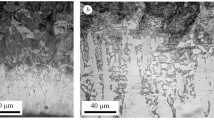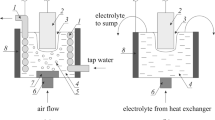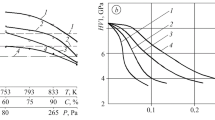Abstract
In recent years technological processes and methods of treatment that include the use of low-temperature gas-discharge plasma have become very popular. Ion-plasma technologies are used successfully for cleaning the surface of materials or creating thin-film structures and coatings and for chemicothermal treatment (nitriding, siliconizing, boronizing, carburizing, etc.) of various metals and alloys. The effect of the plasma of a gas glow discharge on a solid body can be manifested in a change in the chemical composition of its surface region. This is caused by the introduction of elements from the gas atmosphere into the specimen and by the redistribution of the matrix components in this region. The nature of such a redistribution of the components under the action of a gas-discharge plasma is not completely clear, which, among other reasons, is associated with the insufficiency of experimental and theoretical data on the problem. The present work concerns the causes and possible mechanism of the appearance of an oxygen-rich layer in the near-surface region of steel 10KhN2 after the action of a glow-discharge plasma in He, N2 + 25% H2, and Ar atmospheres. A correct explanation of this phenomenon can have a decisive role in understanding the special features of the diffusion processes occurring in a solid body under the effect of a gas-discharge plasma.
Similar content being viewed by others
References
V. Yu. Nosenko, A. L. Pivovarov, S. P. Chenakin, and V. T. Cherepin. “Modification of multilayer Cu-Ni and Cu-Cr thin films under the effect of the plasma of a hf-discharge in an N2 atmosphere,”Metallofizika,14(8), 70 - 78 (1992).
R. A. Andrievskii and Ya. S. Umanskii,Interstitial Phases [in Russian], Nauka, Moscow (1977).
A. A. Babad-Zakhryapin and G. D. Kuznetsov,Traditionally Stimulated Chemicothermal Treatment [in Russian], Énergoizdat, Moscow (1982).
V. Yu. Nosenko, A. L. Pivovarov, S. P. Chenakin, and V. T. Cherepin, “Numerical solution of the equation of mass transfer in ionplasma saturation of solid bodies,”Metallofizika,14(2), 86 - 90 (1992).
Author information
Authors and Affiliations
Additional information
Translated from Metallovedenie i Termicheskaya Obrabotka Metallov, No. 4, pp. 26 – 28, April, 1996.
Rights and permissions
About this article
Cite this article
Nosenko, V.Y., Pivovarov, A.L., Chenakin, S.P. et al. Special features of oxygen distribution in the surface region of steel IOKhN2 under the effect of gas-discharge plasma. Met Sci Heat Treat 38, 174–176 (1996). https://doi.org/10.1007/BF01401516
Issue Date:
DOI: https://doi.org/10.1007/BF01401516




